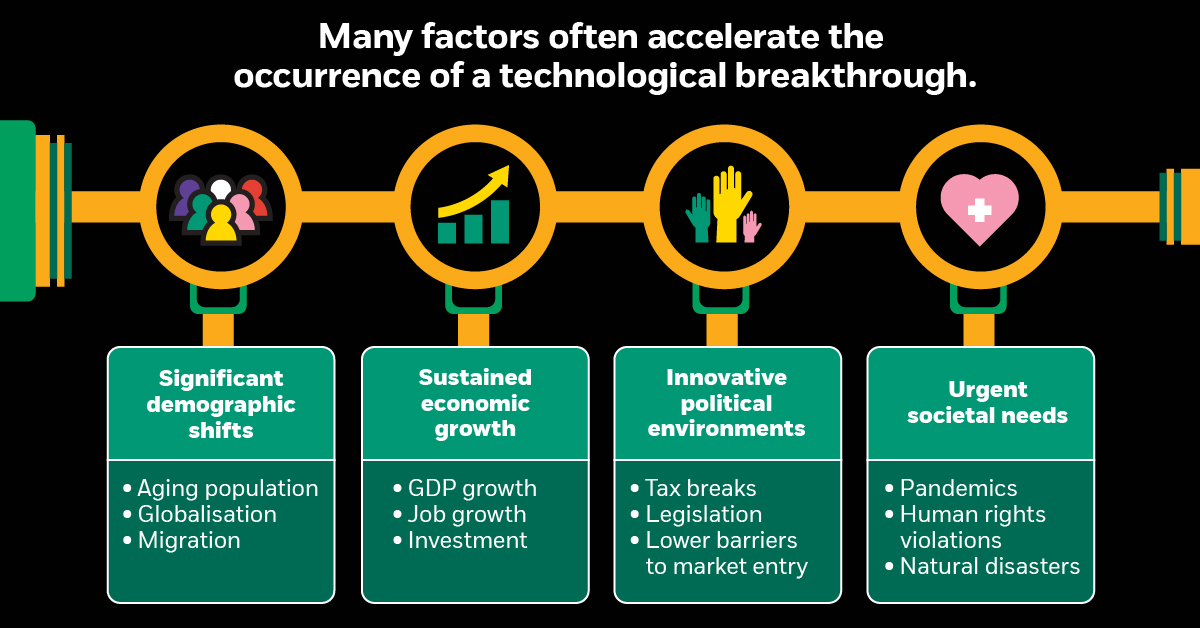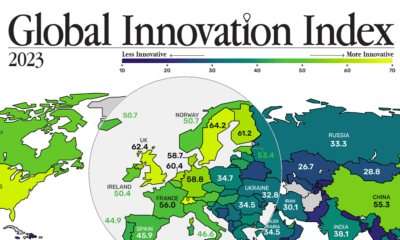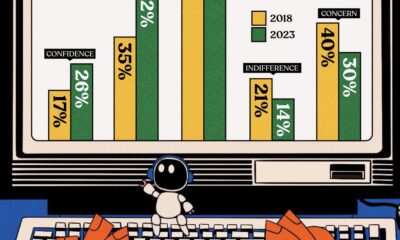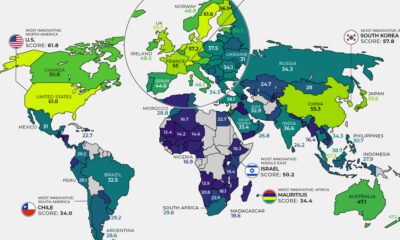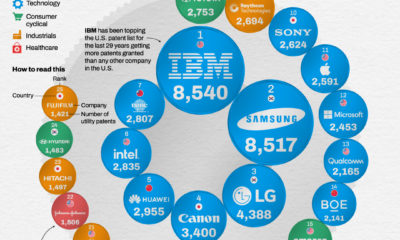Technology
An Investing Megatrend: How Technological Breakthroughs are Shaping the Future
Since Apple released the first iPhone in 2007, few industries have been left unaffected.
This transformational device is a prototypical example of a technological breakthrough. It was a tipping point in turning entire business models upside-down, while also impacting our everyday lives at a more fundamental level.
New growth opportunities emerged from the ensuing disruption, while many status quo solutions were rendered obsolete.
Technological Game-Changers
Today’s infographic from BlackRock highlights the pervasive and positive impact that technological breakthroughs can have on the global economy.

Fueling the Flames of Innovation
According to recent data from Accenture, it’s estimated that 71% of businesses are on the brink of being disrupted.
In fact, disruptive innovation most often emerges in two scenarios:
- New solutions to existing problems or challenges that have proven difficult to solve
- New competitors in highly profitable sectors with historically high returns
The occurrence of technological breakthroughs can also be accelerated through several factors, including significant demographic shifts, sustained economic growth, innovative political environments, and urgent societal needs.
Technological Adoption is Speeding Up
Breakthrough inventions have always sent ripple effects throughout society, but today those ripples are travelling faster than ever.
Moore’s Law – the assertion that number of components in a dense integrated circuit (i.e., transistors, resistors, diodes, or capacitors) will double every year, while still getting cheaper – is one factor. Similar examples of staggering increases in utility for less cost can be found in a number of other instances, from DNA sequencing to data storage.
The rate of technological adoption is also speeding up. For example, consider the mobile phone─due to the price point and ease of use, the number of U.S. adults with a cell phone jumped from 10% in 1994 to over 96% in 2019. This is also evident in new technologies such as smart speakers, where the adoption rate in the U.S. is expected to double to 55% in less than 3 years.
Breakthrough Investment Opportunities
Where innovation leads, investment usually follows. However, predicting which technological innovations will have a lasting impact on society has often proved difficult.
Instead, investors can track the wider trends that often spark technological disruption, in order to unlock potential opportunities:
- Research and Development Funding:
The number of investments in emerging technologies is growing. Tech company acquisitions also totalled US$278 billion by Q2 2018—a 50% increase from the year before. - The Future Workforce:
Historically, productivity gains have increased the demand for more skilled labour. Technical and soft skills are top priorities for employers for their future teams, and it it’s projected that the amount of hours that workers spend using technological skills will increase by 55% from 2016 to 2030. - Shifts in Consumer Demand:
Companies aware of these factors should seek to incorporate innovations into their platforms for a more customer-centric experience. - Societal Needs:
Persistent global social issues such as access to better healthcare are drivers of innovative solutions that offer a better quality of life. Symphony Post-Acute Network harnessed artificial intelligence (AI) and machine learning (ML) to be able to offer personalised healthcare for over 80,000 patients─cutting costs by more than US$13,000 per patient.
Future Impact of Technological Innovation
Technological change will likely continue to accelerate, and investors should tailor their portfolios accordingly.
At the same time, traditional barriers to entry for new competitors are consistently being eroded by these breakthroughs, sending industries into flux and creating potential new opportunities.
Humanity’s co-evolution with technology will continue to profoundly impact the economy, while improving life on Earth in unimaginable ways.
Technology
Visualizing AI Patents by Country
See which countries have been granted the most AI patents each year, from 2012 to 2022.

Visualizing AI Patents by Country
This was originally posted on our Voronoi app. Download the app for free on iOS or Android and discover incredible data-driven charts from a variety of trusted sources.
This infographic shows the number of AI-related patents granted each year from 2010 to 2022 (latest data available). These figures come from the Center for Security and Emerging Technology (CSET), accessed via Stanford University’s 2024 AI Index Report.
From this data, we can see that China first overtook the U.S. in 2013. Since then, the country has seen enormous growth in the number of AI patents granted each year.
| Year | China | EU and UK | U.S. | RoW | Global Total |
|---|---|---|---|---|---|
| 2010 | 307 | 137 | 984 | 571 | 1,999 |
| 2011 | 516 | 129 | 980 | 581 | 2,206 |
| 2012 | 926 | 112 | 950 | 660 | 2,648 |
| 2013 | 1,035 | 91 | 970 | 627 | 2,723 |
| 2014 | 1,278 | 97 | 1,078 | 667 | 3,120 |
| 2015 | 1,721 | 110 | 1,135 | 539 | 3,505 |
| 2016 | 1,621 | 128 | 1,298 | 714 | 3,761 |
| 2017 | 2,428 | 144 | 1,489 | 1,075 | 5,136 |
| 2018 | 4,741 | 155 | 1,674 | 1,574 | 8,144 |
| 2019 | 9,530 | 322 | 3,211 | 2,720 | 15,783 |
| 2020 | 13,071 | 406 | 5,441 | 4,455 | 23,373 |
| 2021 | 21,907 | 623 | 8,219 | 7,519 | 38,268 |
| 2022 | 35,315 | 1,173 | 12,077 | 13,699 | 62,264 |
In 2022, China was granted more patents than every other country combined.
While this suggests that the country is very active in researching the field of artificial intelligence, it doesn’t necessarily mean that China is the farthest in terms of capability.
Key Facts About AI Patents
According to CSET, AI patents relate to mathematical relationships and algorithms, which are considered abstract ideas under patent law. They can also have different meaning, depending on where they are filed.
In the U.S., AI patenting is concentrated amongst large companies including IBM, Microsoft, and Google. On the other hand, AI patenting in China is more distributed across government organizations, universities, and tech firms (e.g. Tencent).
In terms of focus area, China’s patents are typically related to computer vision, a field of AI that enables computers and systems to interpret visual data and inputs. Meanwhile America’s efforts are more evenly distributed across research fields.
Learn More About AI From Visual Capitalist
If you want to see more data visualizations on artificial intelligence, check out this graphic that shows which job departments will be impacted by AI the most.
-

 Mining1 week ago
Mining1 week agoGold vs. S&P 500: Which Has Grown More Over Five Years?
-

 Markets2 weeks ago
Markets2 weeks agoRanked: The Most Valuable Housing Markets in America
-

 Money2 weeks ago
Money2 weeks agoWhich States Have the Highest Minimum Wage in America?
-

 AI2 weeks ago
AI2 weeks agoRanked: Semiconductor Companies by Industry Revenue Share
-

 Markets2 weeks ago
Markets2 weeks agoRanked: The World’s Top Flight Routes, by Revenue
-

 Countries2 weeks ago
Countries2 weeks agoPopulation Projections: The World’s 6 Largest Countries in 2075
-

 Markets2 weeks ago
Markets2 weeks agoThe Top 10 States by Real GDP Growth in 2023
-

 Demographics2 weeks ago
Demographics2 weeks agoThe Smallest Gender Wage Gaps in OECD Countries

